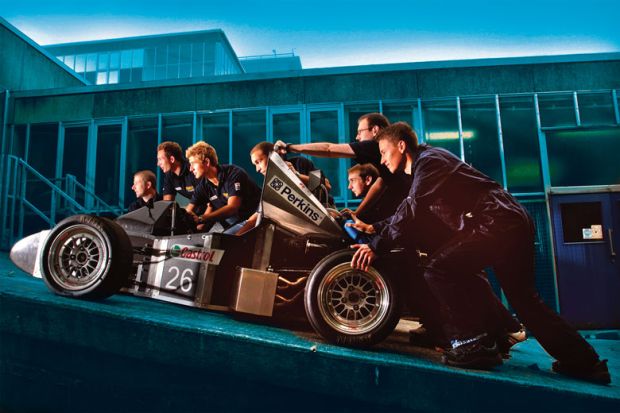Several years ago, I received an early morning call from the security desk to say undergraduate students were sleeping in one of the university’s workshops. Apparently, this was not the first time, and, understandably, security – not to mention facilities, health and safety, and, I suspected, many others – quite reasonably wanted this behaviour to stop.
While I dreaded what I expected would be evidence of the excesses from the previous night, I had a spare hour before my next meeting, so I headed off to the workshop in question to see for myself. To my amazement, it was spotless. Moreover, it was humming with a group of about 20 students enthusiastically working on a half-finished racing car at its centre.
It quickly became clear that there had been no sleeping whatsoever, nor any kind of debauchery. The car was due to be raced at a student competition in four weeks’ time and this group had been on campus since 4am passionately working on it. The students were about to have breakfast and they invited me to join them and learn more.
While the smell of fresh bagels and coffee was inviting, I was initially reluctant. Despite having an engineering degree, I have a surprising lack of interest in engines and find the idea of burning fossil fuel for fun on an already warming planet challenging. However, my attempts to politely recuse myself were rapidly overpowered by the sheer zeal of my hosts. I also had a nagging unanswered question about the source of their abundant motivation.
I was glad I stayed. It turned out the car was electric, something that any self-respecting engineer should have been able to immediately identify from the lack of an exhaust system. However, this was not my most humbling lesson.
Ivan, an enthusiastic young man in blue overalls, informed me that the students were part of a group of over 150, drawn from different year groups and disciplines across the university. Each year, they design, build and race a new high-performance motor car from scratch. As we talked, it also became clear that their goals were achieved via a set of sophisticated governance, fund-raising, risk management and health and safety practices that would be the envy of any professional organisation.
The only thing the university had really contributed to the project was the environment. This clearly included the workshop space and associated kit, but even these could have been rented more cheaply elsewhere. There was also the knowledge that the students were applying, although much of this was available from any public library or large class lecture series – places where, I know for certain, students often do actually sleep.
What was crucial for this project, though, was the university’s community of talented, outward-looking students, which was being leveraged to create a group that was self-facilitating peer-to-peer learning, with opportunities to develop and test ambitious ideas and build resilience when some inevitably failed. Perhaps most critically of all, the experience of working on the project was fostering a sense of belonging because of, rather than in spite of, the group’s diversity. The fact that all of this had happened independently of the grand mission statement of the institution was both sobering and inspiring.
The emptying of campuses and the proliferation of cheaper and more convenient online educational offerings are dynamics that predate the pandemic, but they have been accelerated by it. Collectively, these developments present an existential threat that increasingly looms over capital-intensive universities. Staff at these institutions will justifiably point to the strong correlation between solely online learning and poor academic and mental health outcomes. However, to be beneficial in the long term, experiences – particularly expensive and inconvenient ones – must first be attractive and engaging, or they will fail before they begin.
The current evidence of falling attendances at traditional lectures suggests that many universities need to rethink and review the modes and experiences that underpin student learning. As part of a significant evolution of our curriculum – including its purpose and its embedded experiences – this is the discussion we are currently having at Queensland University of Technology.
Two bagels later, I coincidentally left the racing car workshop at the same time as Ivan. As we walked back through campus, I asked him how he was finding university. “It’s great!” he said. “You know, I actually graduated five years ago, but I still come here whenever I can. I get to learn new things and hang out with a great gang, working together on interesting problems we all love.”
Ironically, my next meeting was a discussion about space utilisation. However, as I reviewed the detailed plans and budget projections, I couldn’t drown out the internal voice asking what felt like much more fundamental questions: How can we create more university experiences that combine belonging with lifelong learning? And should I ask Ivan to write our next mission statement?
Nic Smith is provost of the Queensland University of Technology.
POSTSCRIPT:
Print headline: Fostering belonging will attract students to campus
Register to continue
Why register?
- Registration is free and only takes a moment
- Once registered, you can read 3 articles a month
- Sign up for our newsletter
Subscribe
Or subscribe for unlimited access to:
- Unlimited access to news, views, insights & reviews
- Digital editions
- Digital access to THE’s university and college rankings analysis
Already registered or a current subscriber? Login








